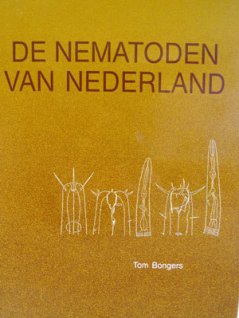
Product
Identification key: De Nematoden van Nederland
In 1988 the first edition of “De Nematoden van Nederland” has been published. In 1994, after the first edition was sold out, an unchanged second edition appeared. This edition is also sold out. A paperback version is now available by POD (Printing On Demand).

This richly illustrated key, focusing on the identification of the Dutch terrestrial and fresh-water nematodes, is used worldwide. The hardcover version is sold out, but a paperback version can be ordered at KNNV-Uitgeverij (POD).*
Bongers, Tom (1994). De Nematoden van Nederland. KNNV-bibliotheekuitgave 46. Pirola, Schoorl. 408 p.
The price is 39,95 euro.
A paperback copy (POD) can be ordered by filling in the order form on the website of KNNV-Uitgeverij
* Only in Dutch
Book review
Nematologica 35 (1989): 377, E.J. Brill, Leiden
T. Bongers. De Nematoden van Nederland.
Publication Foundation Royal Dutch Natural History Society. 408 pag.
Nematology started very early and immediately at a very high level in the Dutch speaking countries (de Man, Schuurmans-Stekhoven, De Coninck) and they remained an important area for nematological research; at the SEN symposium in Warsaw, 1967, Van Berkum presented a paper in which he showed that at that time Dutch speaking nematologists formed a very large group in Europe. It is not surprising, therefore, to find a book on identification of nematodes in Dutch which, it is claimed "can also be used by everyone with knowledge of Germanic languages".
The author, Dr. Bongers, replaced Loof at Wageningen University where he obtained his doctor's degree with a study of very large marine nematodes living in sponges (Leptosomatidae). On switching to the identification of soil nematodes he soon realized that no general work for identifying soil nematodes was available and so he set to to compile one himself. The author's main problem was to know what species occur or can occur in the Netherlands and in Belgium: the nematofauna of non-agricultural soils is incompletely known and some systematic groups have not yet been thoroughly studied.
The result is an impressive, well written, well illustrated book that will become the major identification source certainly for elementary students. They may have difficulties in following the key to families and genera (pp. 33-51) but the fifteen pages with only outline drawings (pp. 52-66) permit a very rapid identification of most genera. Keys to species are kept very short: for each species, description and drawings permit a detailed comparison. Beginners in nematodeidentification have always had difficulty relating drawings to what they see under the compound microscope: excellent photographs next to the drawings help them overcome this. This hard-cover book with many illustrations is sold at a very low price: the publisher is a non-profit organisation that promotes nature education.
E. Geraert